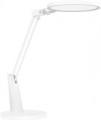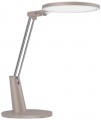Maximum power
The maximum power of the light source allowed for a given lamp.
This parameter has different meanings depending on the light source (see the corresponding paragraph). It is most critical for models with sockets for replaceable light bulbs: the power of the light bulbs used should not exceed the maximum power of the lamp. Otherwise, it will overheat, and the consequences can be very unpleasant - even a fire. In this case, for models with several cartridges, the total power of all installed light sources is indicated. In order to determine the maximum permissible power of an individual light bulb, you need to divide the total limitation by the number of sockets. For example, in a model with 7 “seats” and a limit of 140 W, you can install bulbs of no more than 140/7 = 20 W.
It is also worth recalling that the actual brightness of the light bulb will depend not only on its power, but also on its type. Thus, at the same brightness, “energy-saving” fluorescent lamps have a power 3 to 5 times less than incandescent lamps, and LED light sources - 10 times less. Thus, low permissible power does not interfere with achieving high brightness.
As for table lamps with built-in LEDs, the maximum power for them corresponds to the actual power of the LED unit. You can roughly estimate the capabilities of such a lamp using the above formula - the brightness of the LED corresponds to the brightness of an incandescent lamp with 10 times more power. For example..., if you previously made do with a 60-watt light bulb, an 8-watt LED lamp will most likely be enough for you.
Wattage also determines the energy consumption of the lamp. However, it is not particularly high in table lamps, and in models with a replaceable socket, it also depends not on the maximum power of the lamp itself, but on the characteristics of the actually installed light bulbs.
Luminous flux
Luminous flux provided by a lamp. This parameter is indicated only for models using built-in LED modules (see “Light source”) - in lamps with a socket, it will depend on the light bulbs used.
Luminous flux is essentially the brightness of the lamp. The brightness itself in lumens tells little to the average user, a non-specialist; however, there are tables that allow you to compare the luminous flux of a lamp with a particular light source of standard brightness. For example, a 40 W incandescent lamp produces about 415 lm, a 60 W lamp produces 710 lm, and a 100 W lamp produces 1340 lm. More detailed tables for comparison can be found in special sources.
Speaking of brightness, it is also worth noting that it should not be too low or too high: both create discomfort, increase fatigue and can lead to eye problems. Reference sources provide recommendations on optimal brightness for different tasks. However, this point can be determined for yourself experimentally. And if in doubt, you can purchase a lamp with adjustable brightness (see “Functions and capabilities”).
Colour temperature
The colour temperature of the light emitted by the lamp. It is indicated only for models with built-in LED (see "Light source"), since bulbs with different characteristics can be installed in the socket. In luminaires with
colour temperature control(see "Features"), the minimum value is usually taken into account.
This parameter directly determines the hue of the visible colour. At the same time, its physical meaning is such that as the colour temperature rises, this shade becomes more
“cold”, shifts from yellow to blue. Here are some examples of colour temperature, for clarity:
— 1500 – 2000 K — candle flame;
— 2800 K — 100 W incandescent lamp (
warm light);
— 4000 K — a fluorescent
lamp of daylight white light(such light can already be perceived as cold);
— 5000 K — the light of the midday sun;
— 5500 K — a shade from white clouds at noon;
And so on, thickening to blue cold shades.
Note that the choice for this parameter depends not only on personal preferences and design considerations, but also on the general purpose of the lamp. So, a high colour temperature (from 5000 K) is considered optimal for reading, an average colour temperature (about 4000 – 5000 K) is comfortable for mathematical calculations, working with documents and other tasks that require concentration, and
...soft warm light up to 4000 K is good for relaxing and creating atmosphere of comfort.
